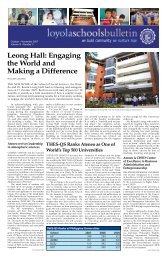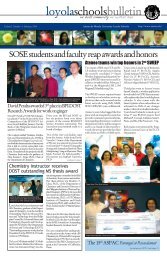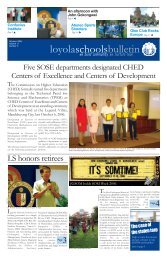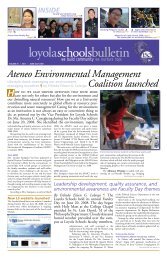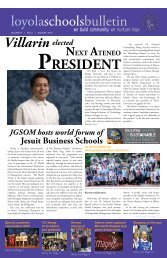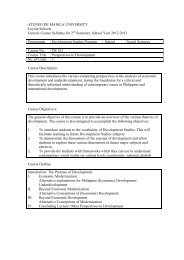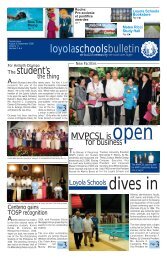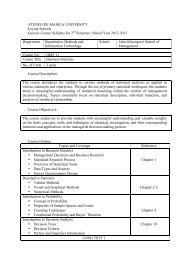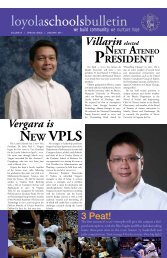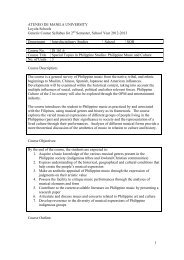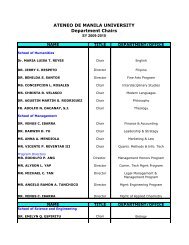ORO, & DAVAO - Ateneo de Manila University
ORO, & DAVAO - Ateneo de Manila University
ORO, & DAVAO - Ateneo de Manila University
You also want an ePaper? Increase the reach of your titles
YUMPU automatically turns print PDFs into web optimized ePapers that Google loves.
VOLUME VI | NO. 3 | DECEMBER 2010<br />
13<br />
Printable and paintable<br />
Solar Cells<br />
S i l i c o n -<br />
based solar<br />
cells have been<br />
around for<br />
more than 50<br />
years and yet<br />
they are still<br />
not wi<strong>de</strong>ly<br />
used today,<br />
David So, a researcher for even when<br />
the project, <strong>de</strong>monstrates p e t r o l e u m -<br />
a DSSC <strong>de</strong>vice based energy<br />
cost and <strong>de</strong>mand are rapidly increasing.<br />
This scenario is very much unlike the<br />
computer chip, which was discovered<br />
at around the same time as silicon solar<br />
cells, but whose <strong>de</strong>velopment had been<br />
quite rapid. Today, computer chips are<br />
ubiquitous in today’s common <strong>de</strong>vices<br />
such as computers, cell phones, displays,<br />
sensors, and many others. Well, the<br />
simplest explanation is that the cost<br />
of silicon used for solar cells remains<br />
too expensive for common folk, and<br />
this is largely attributed to the cost of<br />
manufacturing the material. Thus, one<br />
of the grand engineering challenges<br />
of this century 1 is to make solar cells<br />
affordable. While there are still advances<br />
in improving the efficiencies of siliconbased<br />
solar cells to improve the cost-toefficiency<br />
ratio, there is also wi<strong>de</strong>spread<br />
research in alternative types—the newest<br />
are the third-generation solar cells which<br />
are not based on silicon.<br />
At the Chemistry Department of<br />
the School of Science and Engineering,<br />
Dr. Erwin P. Enriquez and his group of<br />
Chemistry and Materials Science and<br />
Engineering stu<strong>de</strong>nts are doing research<br />
on the so-called dye-sensitized solar cells<br />
(dssc). This dssc is a third-gen solar<br />
cell that was discovered by Michael<br />
Grätzel at the Swiss Fe<strong>de</strong>ral Institute<br />
of Technology in Lausanne in the early<br />
1990’s 2 . This amazing invention, which<br />
has gained much attention and recently<br />
won Grätzel Finland’s 2010 Millennium<br />
Technology Prize, promises to provi<strong>de</strong> a<br />
cheaper alternative to silicon-based solar<br />
cells.<br />
What makes dssc so attractive is the<br />
fact that the fabrication process for this<br />
solar cell can use simple procedures such<br />
as printing or painting—and this makes<br />
it amenable to roll-to-roll printing such<br />
as what is used in the newspaper industry<br />
continued on page 12<br />
Dr. Erwin P. Enriquez<br />
for affordable mass production of solar<br />
cell modules, and one can also imagine a<br />
future where rooftops are painted or glass<br />
panes are laminated with these <strong>de</strong>vices<br />
to harvest the energy from sunlight that<br />
constantly impinges us year-round in the<br />
Philippines. The components of the cells<br />
are also generally cheaper than silicon.<br />
Worldwi<strong>de</strong> research and <strong>de</strong>velopment<br />
on this <strong>de</strong>vice is rapid, and there is a rush<br />
towards finding the right ingredients (or<br />
“ink”) either to improve the efficiency<br />
(currently, the highest reported is 11%<br />
and it is estimated that 15% efficiency<br />
makes it very competitive), to further<br />
lower cost and improve stability.<br />
The dssc works like an electrochemical<br />
cell wherein sunlight is converted into<br />
electricity by the combination of the<br />
dye, nanoparticles of titania (TiO 2<br />
),<br />
and electrolyte in a layered structure<br />
sandwiched between two conducting<br />
electro<strong>de</strong>s (one of which is transparent<br />
to light). The dye is a colored pigment<br />
that absorbs sunlight thus raising its<br />
energy (it gets “excited”). Analogous<br />
to water that flows from higher level to<br />
lower level, an electron from the excited<br />
dye readily “flows” down into the lower<br />
energy level of the nearby nanoparticles<br />
of titania, which in turn allows the<br />
electron to flow into the external circuit<br />
through the transparent, conducting<br />
electro<strong>de</strong>. In effect, the <strong>de</strong>vice generates<br />
a voltage much like a battery does, that<br />
can generate electrical current, but in<br />
the dssc case, there is no consumption<br />
of any of the chemical components, and<br />
there is continuous electrical generation<br />
on exposure with light.<br />
The research that Dr. Enriquez’s<br />
group is doing consists of making the<br />
inks that could be used in inkjet printing<br />
of the <strong>de</strong>vice. Why inkjet printing<br />
“Because, inkjet printing saves ink, and<br />
it can pattern the <strong>de</strong>position as well,”<br />
Lance Go, a researcher of the project,<br />
explains. “But we are also consi<strong>de</strong>ring<br />
other techniques for fabricating the<br />
<strong>de</strong>vice, although our focus now is to<br />
innovate on the formulation of the<br />
inks for the different components of<br />
the <strong>de</strong>vice: the dye, the titania, or even<br />
the electrolyte. For example, we found<br />
that incorporating a polysacchari<strong>de</strong><br />
extracted from Philippine seaweeds can<br />
stabilize the electrolyte or even be used<br />
Inkjet printing of nano-TiO 2<br />
using a common printer<br />
(LEFT), scanning electron<br />
micrograph of micron-sized<br />
droplets of TiO 2<br />
nanoparticles<br />
(LEFT INSET), and a green<br />
nanomaterial that can be a dye<br />
substitute synthesized at the<br />
<strong>Ateneo</strong> Chemistry Department<br />
(RIGHT).<br />
Potentials of “Lumut”<br />
Microalgae, commonly called<br />
“lumut,” are the primary producers in<br />
bodies of water. They sustain the life of<br />
other of organisms in this habitat. Alson’s<br />
Aquaculture Inc. produces tons of these<br />
microalgae to feed bangus and tilapia.<br />
Lately, the microalgae is being studied<br />
Teresita R. Perez<br />
for its potential for biodiesel production.<br />
We have been conducting experiments<br />
with Chorella vulgaris, Chlorococcum<br />
humicola and Spurina platensis in the<br />
laboratory, where they are stressed to<br />
produce more lipids. These lipids are<br />
potential sources of biofuel.<br />
Ma. Merce<strong>de</strong>s T. Rodrigo<br />
Building Educational Software with<br />
Cura Personalis<br />
Rosalind Picard of the Massachusetts<br />
Institute of Technology <strong>de</strong>fines affective<br />
computing as “computing that relates<br />
to, arises from, or <strong>de</strong>liberately influences<br />
emotions.” With this vision in mind, we<br />
at the Affective Computing group of the<br />
Department of Information Systems and<br />
Computer Science (discs) aim to build<br />
systems that are sensitive to stu<strong>de</strong>nt<br />
moods, feelings, and motivations. We<br />
are interested in emotions that are related<br />
to learning—confusion, boredom,<br />
frustration, and engagement. We are<br />
interested in how these emotions express<br />
themselves through stu<strong>de</strong>nt interactions<br />
with intelligent tutoring systems,<br />
educational games and simulations, and<br />
integrated programming environments.<br />
Through the <strong>Ateneo</strong> <strong>de</strong> <strong>Manila</strong>, the<br />
Department of Science and Technology’s<br />
Philippine Council for Advanced<br />
Science and Technology Research<br />
and Development (pcastrd) and the<br />
Engineering Research and Technology<br />
for Development (erdt) program,<br />
the Affective Computing group has<br />
received in excess of p6 million in<br />
funding since 2007. In that time, the<br />
group has <strong>de</strong>veloped a track record for<br />
publication in international conferences<br />
and journals and has established linkages<br />
with researchers from Carnegie Mellon<br />
<strong>University</strong>, Worcester Polytechnic<br />
Institute, the <strong>University</strong> of Sussex,<br />
the London Knowledge Lab, and the<br />
Laboratorie d’Informatique <strong>de</strong> Grenoble.<br />
These microalgae are useful as<br />
sources of vitamins and nutriceuticals,<br />
and for removal of heavy metals in<br />
waterways. Spurulina tablets are rich<br />
sources of vitamins and the “Chlorella<br />
growth factor,” which are advertised<br />
as vitamins for children, are obtained<br />
from lumut. Microalgae also have<br />
the ability to absorb excess nutrients<br />
in bodies of water, including heavy<br />
metals such as cadmium, so they can<br />
be utilized for “bioremediation.” These<br />
organisms are being grown in the Algal<br />
Culture Collection of the Department of<br />
Environmental Science.<br />
Most of the group’s findings support<br />
teacher intuition: Stu<strong>de</strong>nts who are<br />
bored tend to stay bored. Stu<strong>de</strong>nts who<br />
are bored, confused, or frustrated are<br />
more likely to engage in off-task behavior<br />
or system misuse or abuse. Stu<strong>de</strong>nts who<br />
are engaged are most likely to score well,<br />
to try more challenging problems, and<br />
solve these problems in a minimum<br />
number of steps.<br />
The work’s contribution is in<br />
quantifying these phenomena and<br />
expressing them in mo<strong>de</strong>ls that a<br />
computer can respond to. Emotions<br />
have to be expressed in numbers—<br />
number of correct items solved, number<br />
of cursor keys pressed, time between<br />
program compilations, number of<br />
errors. As additional input, the group<br />
invested in two brain computer<br />
interfaces—Brainfingers and the Emotiv<br />
Epoc. Brainfingers <strong>de</strong>tects and records<br />
the wearer’s electroencephalogram<br />
(eeg), electromyogram (emg) and<br />
electrooculogram (eog) signals. The<br />
Emotiv Epoc on the other hand semiprocesses<br />
these signals, informing the<br />
software of the wearer’s cognitive and<br />
emotional state, as well as his facial<br />
expressions.<br />
The Affective Computing hopes<br />
to contribute to the <strong>de</strong>sign and<br />
<strong>de</strong>velopment of cognitive or emotional<br />
interventions to help stu<strong>de</strong>nts maintain<br />
productive affective states, improve<br />
achievement, and provi<strong>de</strong> stu<strong>de</strong>nts with<br />
a satisfying learning experience.<br />
Microalgae in the algal culture collection of<br />
the Department of Environmental Science



